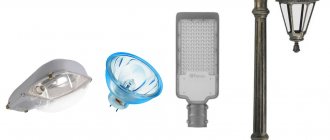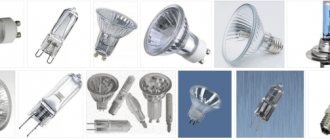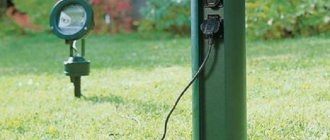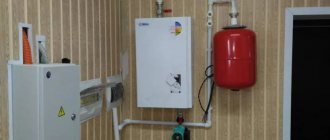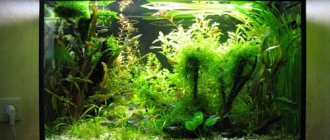Types of lamps
Lamps are divided into types, differing in energy consumption and power.
- Incandescent. The only pet for which this aquarium lighting is suitable is the land turtle. An incandescent lamp overheats the water and produces heat, which does not prevent the growth of algae and pathogenic bacteria. Good quality lamps are energy consuming.
- Luminescent. This is not the best way to properly illuminate an aquarium, but it is quite suitable for unpretentious creatures. Has low power.
- Metal halide. These lamps are a good option for aquariums. They are energy-efficient, small in size, have a long service life, and have high luminous efficiency. Metal halide lamps are similar to natural solar radiation, which has a good effect on the well-being of the inhabitants.
- LED. Suitable for most pets. They are comfortable in terms of aquarium light, durability, and have a wide spectrum of luminescence. The downside of these lamps is the high cost of quality products. It is produced not only in the form of lamps, but also as LED panels and spotlights.
More details about the types of lamps, aquarium lamps, and their characteristics are described separately.
Best Lamps for Saltwater Aquariums
Representatives of this category stand out for their power, allowing the light flux to pass to the very bottom without scattering. It is recommended to use them in deep, large containers. Sometimes these lamps have a function that imitates the light of the moon, which is important for the growth of coral reefs and the spawning of certain species of marine life.
JBL Solar Ultra Marine Day
The white, coolish light of the lamp is ideal for a home pseudo-sea. This glow has a very beneficial effect on the growth of corals. The device has a high level of light output, so you don't have to worry about insufficient lighting at the bottom of the tank. The manufacturer guarantees 8000-10000 hours of uninterrupted operation of the lamp under favorable conditions.
Pros:
- Promotes the development of invertebrates;
- Easy to find on sale;
- Long service life;
- Low power consumption.
Minuses:
- Overpriced.
This lamp is ideal for a reef pond. To obtain excellent illumination and fluorescent results, it is recommended to combine it with Solar Ultra Marin Blue from the same manufacturer.
Hailea Extra Reef T5
The model with a dominance of the blue-violet spectrum is suitable for the inhabitants of a marine aquarium, as it creates an imitation of the illumination of a coral reef at a depth of six meters. This light promotes the growth of unicellular organisms and corals.
Pros:
- Promotes coral growth;
- Excellent quality;
- Aesthetic appearance;
- Reasonable price.
Minuses:
- Rarely found in our stores.
Illumination with such a lamp will make your aquarium a copy of the seabed. Corals, sea fish and cichlids feel great in its light.
Hagen Marine Glo T8
A fluorescent lamp from a Canadian manufacturer produces a limited-spectrum blue glow, ideal for saltwater aquariums. Such lighting will create the appearance of the seabed in the aquarium. In addition to its decoration function, the lamp has a beneficial effect on the growth of corals and invertebrates, and stimulates plant photosynthesis.
Pros:
- Does not increase water temperature;
- Many power options (from 15 to 40 W);
- Suitable for aquariums of different sizes (length 45-120 cm);
- Durable.
Minuses:
- Over time, it loses its “useful” properties.
Marine Glo is suitable for home ponds with reef-dwelling invertebrates. Its light has a good effect on their fluorescent pigments. It is recommended to combine it with Life-Glo or Power-Glo lamps.
Characteristics of aquarium lighting
Basic power standards for lighting devices:
- 0.1-0.3 Watt per liter of aquarium. It is preferred to keep inhabitants with a nocturnal lifestyle, catfish. Of the plants, low power is suitable for Java moss, Vallisneria.
- 0.4-0.5 Watt/l. Plants will grow slowly in such a tank. Shade-loving plants should be planted, because other species will stretch towards the light source and become thin and weak.
- 0.5-0.8 Watt/l. This is the best option for a standard aquarium. The plants grow well and do not lack aquarium light.
- 0.8-1 Watt/l. This power is suitable for fish and plants living in constant direct sunlight. This indicator is also necessary for aquascaping and aquarium keeping with a larger number of plants.
What is the best way to install LED lamps?
In order to install an LED lamp for an aquarium, you do not need to call a specialist; you can do it yourself, following the rules:
- When mounting a lamp above an aquarium, it is recommended to consider covering it with glass. It will help eliminate the possibility of water evaporating, fish jumping out, or liquid droplets getting on the flasks.
- In order to save electrical energy, you can set a timer that will be responsible for turning off the lights.
- It is important to create a light source so that all inhabitants of the aquarium are satisfied. Example: if the vegetation has lost its characteristic shade, the fish have turned pale, then most likely the lamp was installed incorrectly.
- If there is rotting of the root system of vegetation, this indicates that the light bulbs are aimed directly at the roots.
- Do not allow too much light, make calculations before buying a lighting fixture. A green coating on the walls of the tank indicates an excess of light.
Lighting selection
- When choosing equipment, select the intensity and saturation of light. To do this, the characteristics of the tank are taken into account: the number of fish, plants, tank volume, water salinity, amount of water.
- Selecting the lamp type. The impact on fish and cost depend on this choice.
- Choose underwater creatures and greenery with approximately the same light requirements. But you should focus on vegetation, it is this that releases oxygen into the water.
Underwater lighting
If there is a lack of light or additional lighting of parts of the tank, underwater lighting for the aquarium is used - a spotlight. An aquarium light consists of a hermetically sealed container and a bright light source inside. It comes in white, blue, red. Most often used for decoration, intentional lighting of underwater figures or other decor.
The best phytolamps for growing aquarium plants
Models from this category create the best conditions for photosynthesis and growth of aquarium plants. The lamps do not heat the water, do not burn the leaves and do not harm the fauna living nearby.
Dennerle Trocal Special Plant
Dennerle lamps are manufactured using the new Longlife-Technik automated technology, which provides them with more than 10,000 hours of operation. The UV-stop coating film prevents the formation of algae directly on the lamp.
The spectrum gives a glow close to that of the sun and promotes rapid growth of plants (even very fastidious ones). High color rendering ensures that the fish are illuminated in the most advantageous shades.
Pros:
- Suitable for all aquarium lights;
- Very long working life;
- The UV-stop film also protects against flying fragments when dropped;
- Economical.
Minuses:
- Expensive.
To create a unique planted aquarium with proper vegetation, equip your pond with such a lamp. It will also help control algae growth.
Osram T8 Fluora
The fluorescent model has proven itself well not only among aquarists, but also among those who like to grow indoor plants. Still, such a lamp is more appropriate for home ponds: its glow, with an emphasis on the red and blue spectral regions, activates the growth of flora and interestingly highlights aquatic inhabitants.
Pros:
- Does not heat water during operation;
- Many variations in power and size;
- Consumes energy economically;
- Affordable price.
Minuses:
- Over time, it loses its “special” properties.
If the plants in your herbalist have become dull and have stopped growing, pamper them with the glow of an Osram Fluora lamp - they will definitely thank you with lush growth.
Sylvania FHO T5 Aquastar
The spectrum of a fluorescent lamp from a German brand with a high proportion of blue and red radiation is as close as possible to tropical sunlight. This model can be used for both freshwater and marine aquariums. It stimulates the lush growth of plants and corals, highlighting the natural color of fish.
Pros:
- Excellent light output;
- Provides excellent flora growth and protection from algae;
- Lots of power options.
Minuses:
- Light output decreases after 12 months of use due to natural aging.
With such lighting, a tropical aquarium will sparkle with new colors. And the glow of the lamp will not harm either flora or fauna.
Where to place the lighting for the aquarium
Illumination and spotlights are located at the top next to other lamps or on the side walls. Less often, lighting is built into the ground or among greenery.
Number of lamps and their placement
For a small volume tank, one lamp with low power will be enough. But in large tanks you will have to equip two or three high-power lamps.
Lamps are usually placed on top, on the lid. It is also possible to place lighting in the aquarium on the sides of the walls.
How can you light an aquarium?
There are 2 ways to light an aquarium, the aquarist decides which one to choose. What options should you consider:
- Homemade and the simplest. To organize lighting, take an LED strip and glue it around the entire perimeter of the aquarium. The area where the tape is fixed must be insulated. Silicone filler is suitable for this. This method allows the light to be distributed evenly, but the energy efficiency is insufficient. The tape cannot be the only source. To create complete comfortable conditions, additional T5 or T8 LED lamps are required.
- Installation of LED lamps. This creates high-quality and complete lighting. Usually the lamp is assembled by the aquarist himself.
Light intensity
The intensity in the tank should be selected taking into account the specifics of the tank: what is the salinity of the water, how consuming are the plants, color, depth of the water. For these conditions, lamps with optimal lighting are selected.
Selection by volume
Having built the lighting based on the volume, you can change it to suit other conditions. It is important to take not the volume of the container itself, but the volume of water, without air, soil.
One liter in a standard tank requires 0.5-0.8 watts. This value varies depending on the needs of fish and vegetation.
Selection by depth
Selecting the depth of the aquarium lighting is problematic, because light is absorbed every 10 cm of water - 50% of the photons are scattered and do not reach the next layer. If there is good lighting at the top, only a small amount of light will reach the bottom. Therefore, the deeper the aquarium, the more powerful its lighting should be.
Normal aquarium lighting time
The main task of artificial lighting of an aquarium is to bring the habitat for fish and plants as close as possible to the natural one. Since most of them live in tropical and equatorial environments, their day length is about 12 hours. But night time for them does not at all mean pitch darkness, because most of them grow in the shallows and even live in the moonlight at night. These factors determine the activity of fish, behavior during the spawning period, the development of organisms, the intensity of plant photosynthesis, etc.
It should be noted that in addition to the duration, the intensity of lighting plays an important role, because due to the thickness of the water in the aquarium, light radiation is lost in each layer. Some aquarium owners try to compensate for the lack of intensity by supplying bright light for a long time. But this is fundamentally wrong, since the water will begin to bloom and the light spectrum will further decrease.
Rice. 1: Comparison of light transmission of blooming and clear water
Characteristics by time and lighting mode
It is believed that observing the daylight hours is mandatory. After all, the lighting of the aquarium should replicate natural conditions. Let's look at a few nuances about this in the list below.
- Daily strictly developed light regime. One of the adequate options that should be followed for the normal functioning of living organisms. It turns out that the lamp turns on and off at certain times in the evening and in the morning. Due to the passage of seasons and changes in daylight hours, this regime may be adjusted. If the process malfunctions, then this will lead to an imbalance in the aquarium, causing a defect in the reproduction of fish.
- Slow transition from one mode to another. There is no need for harshness in this matter. Switching the light too quickly causes stress in aquatic pets. Therefore, it is recommended to set up the correct chain switching off of the lamps (one after the other after an equal period of time). You can do it the simple way - buy a special socket with a timer sensor. It will automatically turn off the lamp from the network after a specified time.
- Compliance with the duration of the light regime. Typically, daylight hours are 12 hours, which is enough for the normal development of both plants and pets in the aquarium. Please note that more or less time may be unfavorable for the development of animals.
What is combined lighting and how convenient is it?
Experienced aquarium owners create combined aquarium lighting: it consists of several types of lamps. In this way, it is possible to achieve sufficient illumination for the tank, and the costs for this will all be minimal.
Combination options can be any, but the most preferable are: LED and fluorescent; metal halogen and fluorescent. More often, all three types are used simultaneously.
Single light in an aquarium with decor Source nazya.com
Selecting several types of lighting sources is not enough. You also need to be able to install them correctly. For example, the luminescent one often serves as the main one and is installed in the lid of the container at a short distance from the water.
When arranging lighting for an aquarium, LED devices are attached to the side walls of the aquarium so that the lighting falls evenly from both sides into the tank. Functional light supply can also be from the bottom of the tank. Decorative lighting for the aquarium is made in a similar way (some light bulbs are placed in the water column, provided they are highly waterproof), and they try to use different shades of light rays. But here, you should be careful about the choice of light, since too bright and intrusive temperature rays of light can harm aquatic inhabitants.
Original decorative lighting for an aquarium on a remote control Source Pinterest
Incandescent and Halogen lamps.
These lamps are combined into one type. This is due to the fact that they have common advantages and disadvantages. Let's look at them.
The advantage is that the spectrum of light they emit is close to the solar “daylight”, that is, natural. Its low price may also encourage you to choose this type. But you shouldn’t make hasty conclusions and rush into purchasing.
The disadvantages include the strong heating of the lamps, which implies the mandatory presence of a cooler, or the installation height of the lamp.
Low efficiency, as well as their rapid failure.
The average price of this type of lamps for January 2022 is about 50 rubles per 1 piece.
Emission spectrum
You need to take into account not only the lamp power, lighting intensity and size of the aquarium, but also the temperature of the light, which is responsible for the shade of the glow. Color temperature refers to human perception of color and determines tone (warm, cool, neutral), measured in Kelvin. The higher the color temperature, the more blue predominates over red. Different wavelengths of light are perceived as different colors. Short waves of a violet hue turn into longer ones - red. Between violet and red lies the center of the spectrum in the form of a gradient with green and yellow shades. A properly selected lamp for lighting an aquarium imitates sunlight and meets the required spectral values.
The color temperature of light sources for a planted aquarium is 6500–8000 K, and for a reef aquarium – 9000–20000 K. The acceptable range for fish depends on the species and varies from 5500 to 20000 K.
For green plants, lamps that reach extreme values in the blue and red regions of the spectrum are recommended. It is customary to place sources of red spectrum radiation in the foreground, and cold spectrum radiation sources behind.
Daylight hours
You should not try to make up for the lack of lighting intensity with the duration of the backlight. The result will be blooming water. The duration of the backlight largely depends on the type of lamp:
- for LL - up to 10 hours;
- for MGL or DM - up to 8 hours.
The decision on how long to turn on the lamp is made individually. Aquarium lamps should not be turned on half the day. To ensure control, sockets with a timer are used, which can be of two types:
- mechanical, belong to the inexpensive segment, practically do not break;
- electronic, more expensive, very convenient, you can program the time several days in advance.
On a note! Aquarists have mastered another useful new feature - dimmers that can be used to adjust the power.
What can result from improper lighting in an aquarium?
If you choose the wrong system, power or lighting operating mode, you will most likely encounter the following problems:
- Too much daylight will encourage the growth of brown algae. This will lead to the formation of a dark coating on the walls of the aquarium and its bottom. The solution to this problem is to completely replace the water and use disinfection.
- Choosing a low power lamp for an aquarium with great depth will start the process of rotting at the bottom.
- Most of the inhabitants of the aquarium prefer partial shade. In accordance with this, preference should be given to plants that require similar living conditions.
In this article, I tried to cover the topic of lighting your aquarium and everything connected with it as simply as possible. I'm sure it will be useful for beginners! Perhaps professionals will find answers to many questions here.
Read, comment and subscribe for new exclusive articles!
Lamp placement options
Experienced aquarists unanimously agree that the maximum effect can be created by installing a lighting device from above, above the tank. Or install the lamp directly into the aquarium lid.
As an option, hang the light source from the front or one of the side walls of the container. We mount the source switch as convenient for you.
Lighting should be uniform over the entire area, covering the bottom “territory of the ground”. It may turn out that some part of the bottom or volume of water remains in the shade.
This problem can be eliminated by increasing the lamp power, or installing an additional one. As an option, use a submersible lamp and install it at a certain height.
Errors and their consequences
Due to the lack of installation skills and failure to correctly select lighting equipment, the lighting in the aquarium is further reflected in:
- rapid growth of algae (this phenomenon occurs constantly with excess light);
- active development of vegetation shoots (due to non-compliance with lighting conditions);
- coating plants with potassium deposits, as a result of which they lose their attractiveness (usually the main factor influencing this process is increased lighting power). With this approach, it is imperative to install a cooler and filters;
- changing the lighting mode. A similar phenomenon can be observed if you turn the light on and off manually, without using automatic timers.
Lamp with daylight lighting for an aquarium Source garden-zoo.ru
Dimensional lamp on pendants for a large aquarium Source artleds.ru

